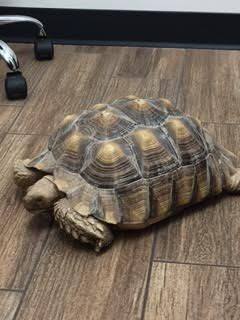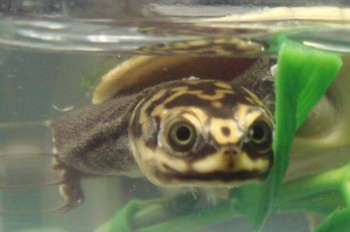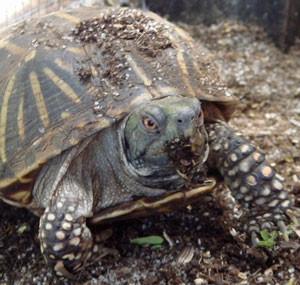|
Turtles/Tortoises: Chelonians
Tortoises:
Are largely herbivore which means that their primary diet should be composed of vegetable matter. Have an upper and lower shell that does not close and no webbing between their toes. The most common problem we see in pet tortoises is the over feeding of protein (dog food) to these guys. Again, you need to research the specific needs for your individual pet, but generally speaking tortoises should have about 80-85% of their diet comprised of leafy greens, mixed veggies and hay. In warm climates the best way to care for most adult tortoises is to allow them to graze outside and supplement some assorted leafy greens and veggies. Tortoises can also be fed fruits, but this should be a small part of their diet and given more as treats than the staple of their diet. Malnutrition in these animals can also be compounded by coprophagy (the eating of their feces) and a captive environment. These two issues lead to increased parasite burden in our captive tortoises. A regular part of their yearly exam should include fecal examination for parasite ova (eggs). I recommend that you always bring a fresh fecal sample with you when visiting the vet. There isn’t anything we love better!Most importantly, prior to buying a tortoise, please research the needs of the animal you are planning on adopting. To provide adequate care you need to understand their nutritional and environmental needs in addition to their longevity and eventual size.Some types of tortoise can become very large, such as Sulcatas. These large pets can be destructive diggers and require a very roomy outdoor enclosure. The most common problem we see in pet tortoises is the over feeding of protein (dog food) to these guys. Again, you need to research the specific needs for your individual pet, but generally speaking tortoises should have about 80-85% of their diet comprised of leafy greens, mixed veggies and hay. In warm climates the best way to care for most adult tortoises is to allow them to graze outside and supplement some assorted leafy greens and veggies. Tortoises can also be fed fruits, but this should be a small part of their diet and given more as treats than the staple of their diet. Malnutrition in these animals can also be compounded by coprophagy (the eating of their feces) and a captive environment. These two issues lead to increased parasite burden in our captive tortoises. A regular part of their yearly exam should include fecal examination for parasite ova (eggs). I recommend that you always bring a fresh fecal sample with you when visiting the vet. There isn’t anything we love better!Most importantly, prior to buying a tortoise, please research the needs of the animal you are planning on adopting. To provide adequate care you need to understand their nutritional and environmental needs in addition to their longevity and eventual size.Some types of tortoise can become very large, such as Sulcatas. These large pets can be destructive diggers and require a very roomy outdoor enclosure.
Aquatic Turtles

Are largely carnivores – meat eaters. Have webbing between their toes One of the more common problems we see in turtles is upper respiratory infection associated with vitamin A deficiency and poor hygiene.Signs include bubbles from the eyes and nostrils, itchy eyes with rubbing of eyes by front legs, swollen eyes (conjunctiva), open mouth breathing and gasping. Unfortunately, in captivity many turtles are kept in dirty environments with water that has been fouled by their food source and feces. It is best to feed turtles in a water source separate from their swimming pool. When artificially confining turtles to captive environments cage hygiene must be an important part of the pet’s upkeep. Food sources for turtles include formulated diets fortified with vitamins and minerals, live food such as small fish, and veggies high in vitamin A for the youngsters.Food:veggies, proteins, fruits Environment: Clean swimming pool with filtration system. An area to dry dock is necessary. Full spectrum lighting – provided by sunlight not filtered through glass, or a fluorescent full spectrum lamp. The lamp should state that it provides both UVA & UVB light. Warmth should be ensured if kept outdoors. Indoors, environmental temperatures often will suffice but I like to include an incandescent bulb for “basking in the sun.”
Box Turtles
Are omnivores – eating both plants and animal products. Are land animals Have a lower shell (plastron) with a “hinge” to allow them to close their shell. These guys should be fed a mixture of protein based  food food  and veggies. Cat food should never be fed. Some suggestions for protein sources include small fish, insects, and formulated parrot diets. Assorted vegetables and fruits should also be offered to the pet box turtle. A common problem with box turtles is that if allowed they will consume only their favorite food and often ingest too much protein. A few ways around this include feeding only veggies when they are the hungriest and mixing food thoroughly to attempt to reduce their ability to pick out individual components. Box turtles should be supplemented with a calcium product and a multivitamin when young. Hygiene is also important with these turtles and can especially be a problem because they will frequently defecate in their water source leading to increased bacteria and parasite loads. Box turtles require a high environmental humidity level and should have access to a very shallow pool of clean water at all times. The water must be cleaned daily because turtles will typically defecate while soaking. Box turtles should be fed a mixture of vegetables and protein. They are often deficient in vitamin A so a vegetable rich source should be fed daily such as squash, sweet potatoes and peppers. I’ve provided a link below for a formulated turtle diet (turtle brittle) that can comprise a portion of their diet (the protein). A variety of greens should also be fed daily and a limited portion of fruits and berries. All food should be finely diced when served. and veggies. Cat food should never be fed. Some suggestions for protein sources include small fish, insects, and formulated parrot diets. Assorted vegetables and fruits should also be offered to the pet box turtle. A common problem with box turtles is that if allowed they will consume only their favorite food and often ingest too much protein. A few ways around this include feeding only veggies when they are the hungriest and mixing food thoroughly to attempt to reduce their ability to pick out individual components. Box turtles should be supplemented with a calcium product and a multivitamin when young. Hygiene is also important with these turtles and can especially be a problem because they will frequently defecate in their water source leading to increased bacteria and parasite loads. Box turtles require a high environmental humidity level and should have access to a very shallow pool of clean water at all times. The water must be cleaned daily because turtles will typically defecate while soaking. Box turtles should be fed a mixture of vegetables and protein. They are often deficient in vitamin A so a vegetable rich source should be fed daily such as squash, sweet potatoes and peppers. I’ve provided a link below for a formulated turtle diet (turtle brittle) that can comprise a portion of their diet (the protein). A variety of greens should also be fed daily and a limited portion of fruits and berries. All food should be finely diced when served.
Flooring:
Preservative and chemical free soil or mulch rich in coconut bark and sphagnum moss will allow the turtle to burrow and will also help to maintain high humidity levels. Water: A shallow pool of water should be kept in the enclosure and should be cleaned daily. Turtles will drown in deep water so the pool should only be about 1in deep and should have easy access for entering and exiting. Again, it is very important to keep the pool water clean to avoid bacterial build up and infections.Shelter: If kept outdoors natural plant shelter is best and is needed to allow cooling, but if the turtle is kept indoors artificial plants can be placed around the enclosure and will provide the same feeling of shelter and security for the turtle.Lighting: Sunlight is always the best, but if kept indoors the enclosure should have a full spectrum (UVA and UVB) light within 18in. of the floor and a basking light to allow for additional warmth.Temperature: Average indoor temperatures are usually appropriate, but again a basking light should be provided to allow for additional heating up to about 85F.Supplementation: Food should be sprinkled with a phosphorus free calcium supplement.

Common Disease Problems:
The most common problems we see in turtles are always related to an inadequate diet and environment. The best way to keep your pet healthy is to practice preventative medicine which is really just providing a good diet and environment. A problem we commonly see in turtles is respiratory infection related to vitamin A deficiency and too dry an environment. These turtles will have swollen eyes, bubbles form their nostrils and eyes and may sound congested. Many will be unable to open their eyes and may also have stopped eating
Turtle/Tortoise Generalizations:
Nutritional needs will vary with species
Will benefit from regular sunlight Often suffer from malnutrition, parasites and bacterial infections
If allowing your turtle or tortoise to graze in your yard be aware of potential predators including the family dog.
We frequently see injured turtles that the family dog thought would be a great chew toy.
|